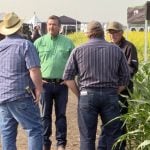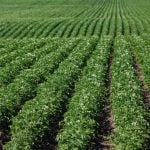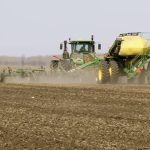It was only a few years ago that interest in alternative methods such as biologicals to boost a crop’s nutrient uptake seemed to spike in popularity. But according to Spencer Harris, senior vice-president of global ag retail for Nutrien Ag Solutions, biologicals are not all that new for Nutrien — the global ag retailer has been researching biological crop inputs for nearly two decades.
Oats

Interest in biological crop inputs continues to grow
Nutrien exec shares thoughts on uptake and profitability of biological crop inputs

Alberta Crop Report: Rains in the south, dryness in the north
Rain fell onto the southern half of Alberta last week, while hot and dry conditions persisted in the northern half, according to the province's crop report released on July 18.

Barley, oats sustainability quantified by study
One tonne of oats produced in Saskatchewan has a carbon footprint 201 per cent lower than that produced across the country
The carbon footprint of oats and barley grown in Saskatchewan is lower than the same crops grown elsewhere, according to new study from the Global Institute for Food Security.

General Mills changing Nature Valley labels after lawsuit’s glyphosate claim
General Mills Inc agreed to stop calling the oats in its Nature Valley granola bars 100 percent natural to settle a lawsuit by three consumer groups that said the bars contained small amounts of glyphosate herbicide, commonly known as Roundup.

Coccidiosis in beef calves
Veterinary Case Study: Treatment protocols to help manage this common, yet troubling, disease
Nate walked through a pen of calves he had just weaned from his first-calf heifers. The day before, he’d noticed flecks of blood in some of the stools, but overall, the calves seemed bright and were eating the hay and chopped oats he offered in bunks. Today, however, he saw blood clots in stools and […] Read more

Spring planting in Manitoba close to finished
Province gets very little rain over the week
Dry conditions continued to spur quick seeding progress in Manitoba, as the provincial agriculture department reported spring planting reached 95 per cent complete as of June 3.

As seeding nears end in Alberta, moisture becoming an issue
Planting advances 10 points at 90 per cent complete
Spring planting in Alberta entered the home stretch with overall progress at 90 per cent seeded as of May 27, the province's agriculture department reported. Provincewide, the pace put Alberta farmers nine points above the five-year average.

Manitoba Crop Report: Dry conditions speed up planting
Dry conditions allowed Manitoba farmers to accelerate seeding to 85 per cent completion during the week ended May 25, 2025.

Grain deliveries up on year in April: StatCan
Barley the lone exception
Almost all major grains delivered in April had notable increases from the previous April, Statistics Canada reported on May 26.

Alberta spring planting slows, but remains ahead of average
Good levels of soil moisture provincewide
Despite some delays, spring planting in Alberta remained well ahead of the five-average, according to the May 23 report from the province's agriculture department.



